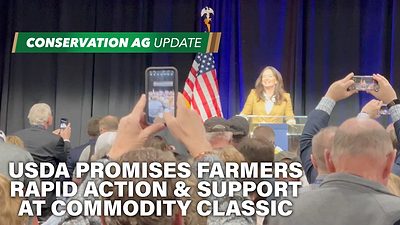Dry weather is pervasive across the state of Pennsylvania this fall. This means even many of those perpetual wet spots have dried up, opening an opportunity to alleviate soil compaction using subsoilers.

Modern sub-soilers have straight shanks, may have winged points to increase subsoil fracturing, and have attachments to limit soil blowout- and residue disturbance.
Soil compaction affects physical, chemical and biological properties of the soil negatively for crop growth. It leads to increased bulk density, reduced porosity, increased penetration resistance, and reduced water infiltration and percolation. Soil compaction also increases the potential for denitrification and ammonia volatilization due to reduced aeration and water infiltration. Uptake of potassium and phosphorus is reduced due to root growth inhibition and reduction in soil biological activity, so it is important to minimize compaction. But common field activities using heavy equipment, especially when soil is wet, trampling by livestock and soil tillage may have caused soil compaction in the past.
To identify problematic soil compaction use both soil and crop observations. The soil compaction tester, or penetrometer, is one means of compaction detection, but it is not useful now since soil conditions are too dry. Instead, take a shovel and dig a hole with a vertical face perpendicular to the crop rows. Push a knife horizontally into the soil profile for about 1 inch starting from the top. You may be able to feel a distinct layer with higher resistance just below common tillage depth. If roots are clearly restricted at a certain depth this may call for action.
Also evaluate the soil structure. Compacted soil structure is massive and does not fall apart in small aggregates whereas root growth is restricted to the cracks between clods.
It is important to evaluate the soil to determine if sub-soiling will be beneficial. Our research has shown that our most common agricultural soils do not benefit from sub-soiling unless they are severely compacted. We are now evaluating sub-soiling on soils with naturally compacted sub-soils called fragipans but still need more years to evaluate the practice. The recommendation is therefore not to use a sub-soiler unless the soil is severely compacted. If you decide that sub-soiling is justified, it is time to decide which sub-soiler to use, and how to set it.
There are different types of sub-soilers. With the recognized benefits of surface residue preservation, modern sub-soilers do not turn surface soil over. Modern sub-soilers therefore tend to have narrow shanks, are not parabolic, and may have attachments that actually help to keep residue in place.
There are different types of sub-soilers that can be used without disturbing surface residue much: Some have large winged points that heave the soil and cause much fracturing of the soil, even between shanks. Others, such as the paratill unit, have bent-leg shanks (not common in Pennsylvania). The shanks come down straight, then curve sideways on a 45° angle, whereas the tip is again positioned downwards. Research at the Soil Dynamics Lab in Alabama has shown that paratill shanks do maximum subsurface fracturing, take less power per shank than straight shanks, and do minimum surface residue disturbance.
Despite what some manufacturers may say, in my opinion, it is best to use sub-soilers only under reasonably dry soil conditions. This means you should not be able to make a ball of soil by kneading it in your hand. The soil has to be that dry anywhere in the profile to the depth of tillage.
Contemporary sub soiling is meant to be a one-pass operation so that crops can be planted immediately after sub soiling without secondary tillage. The choice of attachment is very important because it determines surface residue reduction to a large degree. Soil tends to “blow out” behind the shanks (especially when run at higher speeds) so attachments are available to push soil back to create a suitable seedbed. To achieve soil conservation goals, more than 30% residue cover should be present after sub-soiling and planting, so attachments should not cover residue but leave it on top.
Kick-back mechanisms are another necessity on sub-soilers. If not present, shear bolts will have to be replaced on a regular basis in our rocky soils, making sub-soiling an arduous task.
Next is the depth to which the shanks should be set. The sub-soiler should be set approximately 1 inch below a compacted layer (if present). A tractor that can pull the sub-soiler needs to be available. Depending on soil conditions, you should count on approximately 40-50 HP available per shank.
Once sub-soiling has been completed, it becomes necessary to have a plan in place to manage traffic after sub-soiling and build soil structure. The benefits of sub-soiling are easily lost by re-compaction with heavy equipment. In fact, the situation will be worse than before sub-soiling, because the sub-soiled field is more susceptible to rutting. Therefore, use flotation tires on all equipment and reduce tire pressure as much as possible to benefit from a large footprint. Do not exceed 10-ton axle loads, and limit repeated traffic to select areas of the field that can then be treated if needed. After sub-soiling, plant cover crops to increase root mass in the surface and subsoil and rotate crops with different root architectures, such as tap-rooted and fibrous-rooted crops.





